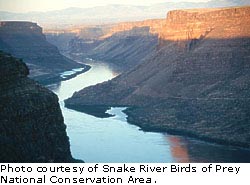About the Columbia River: Grand Coulee Dam to Bonneville Dam

The middle portion of the Columbia River runs over 450 miles from Grand Coulee Dam to Bonneville Dam, where the river serves as the boundary between Oregon and Washington. The Snake River flows in from Idaho and is the largest tributary of the Columbia River. The Snake was once home to at least a third of the salmon run in the Basin.
Below are summaries of key EPA projects in the middle section of the Columbia River basin.
Hanford Cleanup Site in Richland, Washington
The U.S. Department of Energy Hanford Site, located near the City of Richland, Washington, was established to produce nuclear materials for national defense. The Hanford Site was placed on EPA's National Priorities List of contaminated sites in 1989. The Department of Energy entered into the Tri-Party Agreement with EPA and the Washington Department of Ecology, establishing the legal framework and schedule for cleaning up Hanford. EPA has an office in Richland to help oversee the cleanup.
Walla Walla River Basin Pesticide Stewardship Project
Monitoring in two tributaries in the Walla Walla River watershed near Milton-Freewater, Oregon showed a stunning 90 to 95% reduction in the average concentrations of chemical chlorpyrifos (Lorsban) - an insecticide used to control pests on fruit trees and other crops - between 2006 and 2011. The dramatic reduction coincides with a wide range of pesticides management practices implemented by farmers since 2006, including:
- Reducing pesticide drift, which happens when pesticides are applied in ways that allow chemical droplets to move off the farm site, such as during windy weather;
- Installing weather stations to ensure pesticides are applied when weather conditions are best;
- Using non-chemical pest management techniques such as disrupting the mating cycles of pest insects;
- Using less toxic alternative chemicals to control pests.
Similar dramatic reductions in average concentrations of the herbicide diuron (Karmex) were also observed in those same tributaries between 2009 and 2013. The local irrigation districts in the areas reduced the use of diuron by relying on mechanical controls for weeds on ditch banks, as well as occasional spot spraying of a less toxic and persistent herbicide. The pesticides monitoring was part of an Oregon Pesticide Stewardship Partnership Project - a collaborative program funded largely by EPA grants that involves participation by the Oregon Department of Environmental Quality, watershed councils, Oregon State University Extension Service, Oregon Department of Agriculture, agricultural producer groups, tribes, soil and water conservation districts, and local chemical suppliers. The program also helps organize pesticide collection events for old, unusable pesticides that were used in the past - such as DDT - to make sure they do not get into the environment. In July of 2014, over 15,000 pounds of waste pesticides were collected from growers and pesticide applicators on the Oregon side of the Walla Walla Watershed.
Questions? Contact Kevin Masterson (masterson.kevin@deq.state.or.us), Oregon Department of Environmental Quality; or Mary Lou Soscia (soscia.marylou@epa.gov), EPA.
Indian Creek Watershed Outreach in Nampa, Idaho
Indian Creek, which flows through Nampa, Idaho, is a tributary of the Snake River. EPA has awarded the City of Nampa two grants, a small Urban Waters grant and a Special Project Environmental Justice Grant to develop a public education and outreach campaign on stormwater management focusing on the Hispanic community (the Boise/Nampa/Caldwell area is home to one of the fastest-growing Hispanic populations in Idaho). As a result, Nampa's Stormwater Program Team is working to increase the community's awareness of stormwater impacts on water quality in Indian Creek and other local water bodies. These efforts include a bilingual stormwater website which won the 2012 Idaho Press Club competition, bilingual tip sheets for stormwater management, a bilingual storybook that teaches children about the impacts of stormwater runoff, and bilingual stormwater/watershed educational signage at City Acres Park, a popular local park adjacent to Indian Creek. Corporate partners and the local school district are helping with stream cleanup days to foster increased community involvement. EPA has continued a partnership with the City of Nampa to provide EPA Urban Waters funding to continue work efforts to increase community awareness and participation.
Questions? Contact Mary Lou Soscia (soscia.marylou@epa.gov), EPA, 503-326-5873.
